How Do You Spot a Dummy Security Camera?
Spotting a dummy security camera can be as simple as paying attention to key details. Look for shoddy build quality, like flimsy housing and visible seams—real cameras are sturdy and seamless. Blinking red lights are a dead giveaway; authentic cameras avoid such conspicuous indicators. Check for realistic features too: real cameras boast internal storage and remote access, while fakes don’t. Examine the cables; genuine ones use thick, robust wiring, not the flimsy kind. Placement matters as well—an impractically placed camera could be a dummy. By mastering these tips, you’re better equipped to identify fakes and enhance your security strategy.
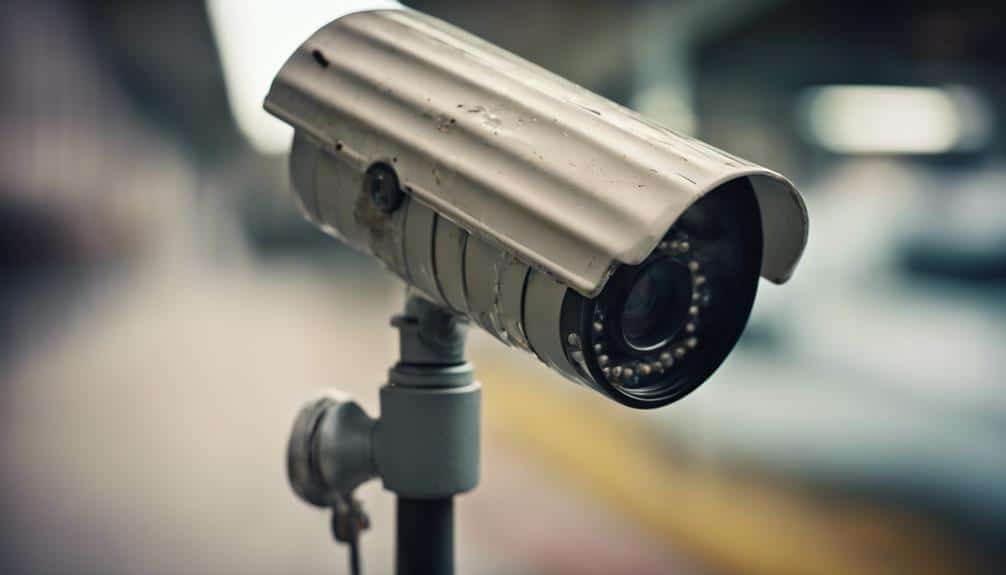 When examining build quality, you’ll notice that genuine security cameras are made from durable materials like aluminum, while dummy cameras often use flimsy plastic.
Real cameras exhibit a high build quality, characterized by seamless joints and sturdy attachment points, giving them a robust feel. In contrast, fake cameras often display poor build quality with visible seams and shoddy craftsmanship, which can be a dead giveaway.
If you pick up a camera and it feels weightless, it’s probably a dummy. Real cameras contain internal components that add to their heft, making them feel substantial. This weight difference isn’t just about heft; it also signals the presence of functional parts inside, unlike the empty shells of dummy cameras.
Additionally, check for weatherproofing features. Real cameras are built to withstand the elements, boasting robust seals and durable materials. Dummy cameras, often made of cheap plastic, may lack adequate protection, making them susceptible to scratches, dents, or uneven surfaces.
When examining build quality, you’ll notice that genuine security cameras are made from durable materials like aluminum, while dummy cameras often use flimsy plastic.
Real cameras exhibit a high build quality, characterized by seamless joints and sturdy attachment points, giving them a robust feel. In contrast, fake cameras often display poor build quality with visible seams and shoddy craftsmanship, which can be a dead giveaway.
If you pick up a camera and it feels weightless, it’s probably a dummy. Real cameras contain internal components that add to their heft, making them feel substantial. This weight difference isn’t just about heft; it also signals the presence of functional parts inside, unlike the empty shells of dummy cameras.
Additionally, check for weatherproofing features. Real cameras are built to withstand the elements, boasting robust seals and durable materials. Dummy cameras, often made of cheap plastic, may lack adequate protection, making them susceptible to scratches, dents, or uneven surfaces.
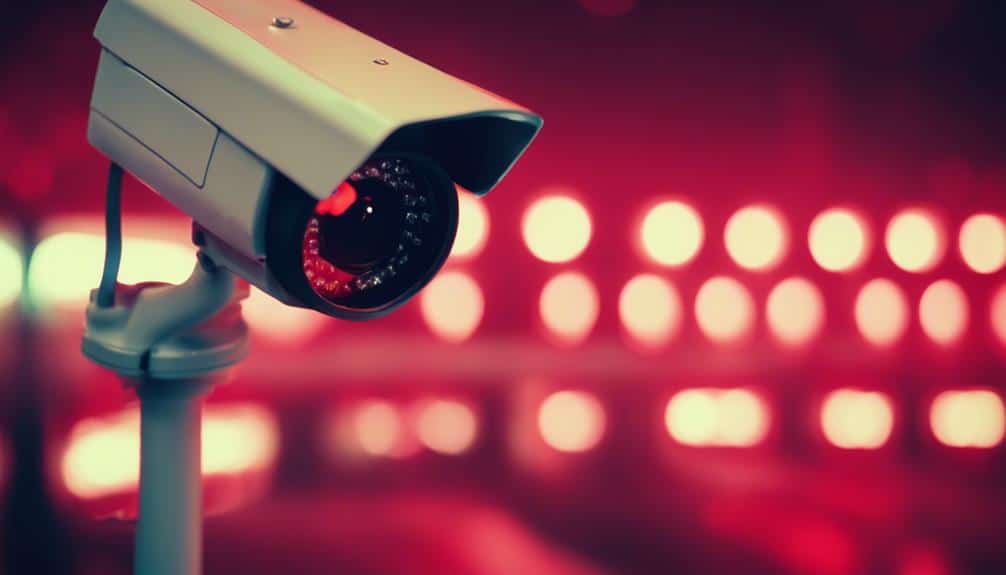 When checking a security camera for infrared capability, get up close and personal with the lens to spot dull red dots indicating working IR lights.
If you’re struggling to see these, whip out your cell phone camera and point it at the lens—real IR lights will show up on your screen, like a hidden treasure map for tech-savvy detectives.
Just remember, if you see bright, blinking red lights, you’ve likely found a dummy camera trying too hard to look real!
When checking a security camera for infrared capability, get up close and personal with the lens to spot dull red dots indicating working IR lights.
If you’re struggling to see these, whip out your cell phone camera and point it at the lens—real IR lights will show up on your screen, like a hidden treasure map for tech-savvy detectives.
Just remember, if you see bright, blinking red lights, you’ve likely found a dummy camera trying too hard to look real!
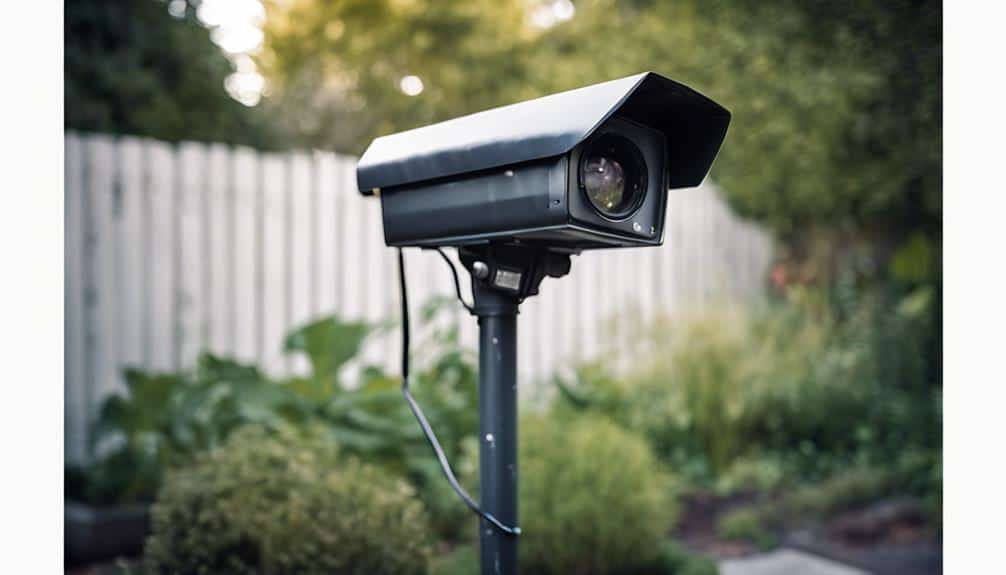 Evaluating the placement of a security camera can reveal essential insights into its authenticity. When you evaluate placement, you’ll often find that a dummy security camera is positioned in odd or impractical locations, like facing a blank wall or hidden behind an awning.
Real ones, however, are strategically installed in high-traffic areas where they can effectively monitor activities and deter potential wrongdoers.
Check the installation quality, too. A genuine camera boasts professional installation, securely mounted with safety features.
On the flip side, a dummy security camera might appear as a DIY project—loosely attached, easily manipulated, and often inadequately weatherproofed. Imagine spotting a camera that’s supposed to be weather-resistant but is oddly sheltered under an eave or inside a garage. That’s a red flag for a fake!
Also, notice any visible wires or sloppy mounting techniques. Authentic cameras typically have hidden or neatly arranged wiring, enhancing their professional look.
If you see wires dangling like a bad hair day, you’re likely looking at a dummy. So, next time you scrutinize a security setup, remember: where and how it’s placed can tell you a lot about whether it’s the real deal or just a clever decoy.
Evaluating the placement of a security camera can reveal essential insights into its authenticity. When you evaluate placement, you’ll often find that a dummy security camera is positioned in odd or impractical locations, like facing a blank wall or hidden behind an awning.
Real ones, however, are strategically installed in high-traffic areas where they can effectively monitor activities and deter potential wrongdoers.
Check the installation quality, too. A genuine camera boasts professional installation, securely mounted with safety features.
On the flip side, a dummy security camera might appear as a DIY project—loosely attached, easily manipulated, and often inadequately weatherproofed. Imagine spotting a camera that’s supposed to be weather-resistant but is oddly sheltered under an eave or inside a garage. That’s a red flag for a fake!
Also, notice any visible wires or sloppy mounting techniques. Authentic cameras typically have hidden or neatly arranged wiring, enhancing their professional look.
If you see wires dangling like a bad hair day, you’re likely looking at a dummy. So, next time you scrutinize a security setup, remember: where and how it’s placed can tell you a lot about whether it’s the real deal or just a clever decoy.
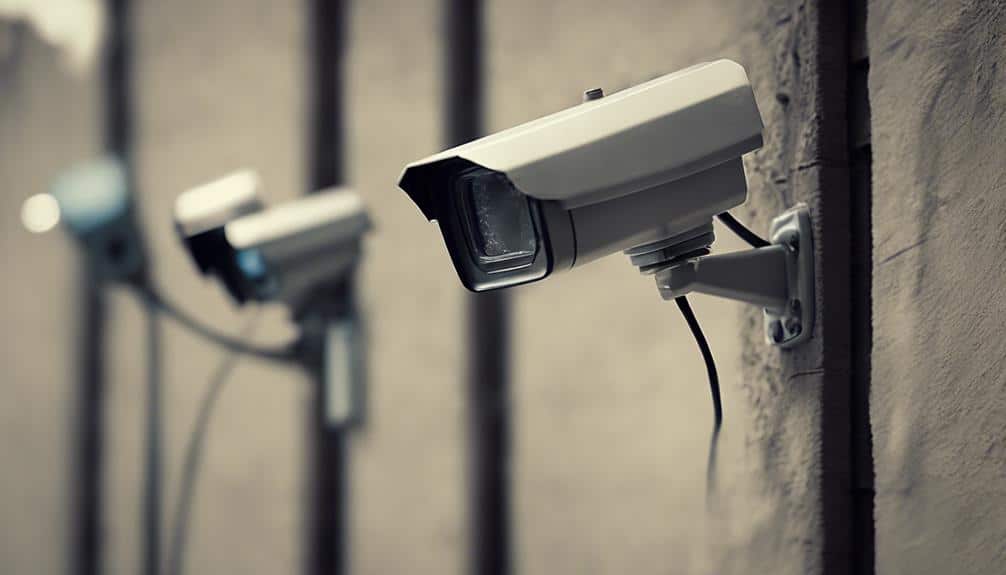 When you’re trying to figure out if a security camera is real, take a close look at the cable type. Genuine cameras usually have thicker, more substantial cables that resemble standard internet cables, while dummies often sport thin, flimsy ones that look like they couldn’t power a flashlight.
Authentic cameras often hide their cables for a sleek appearance, unlike their fake counterparts that shamelessly flaunt them like a bad fashion accessory.
When you’re trying to figure out if a security camera is real, take a close look at the cable type. Genuine cameras usually have thicker, more substantial cables that resemble standard internet cables, while dummies often sport thin, flimsy ones that look like they couldn’t power a flashlight.
Authentic cameras often hide their cables for a sleek appearance, unlike their fake counterparts that shamelessly flaunt them like a bad fashion accessory.
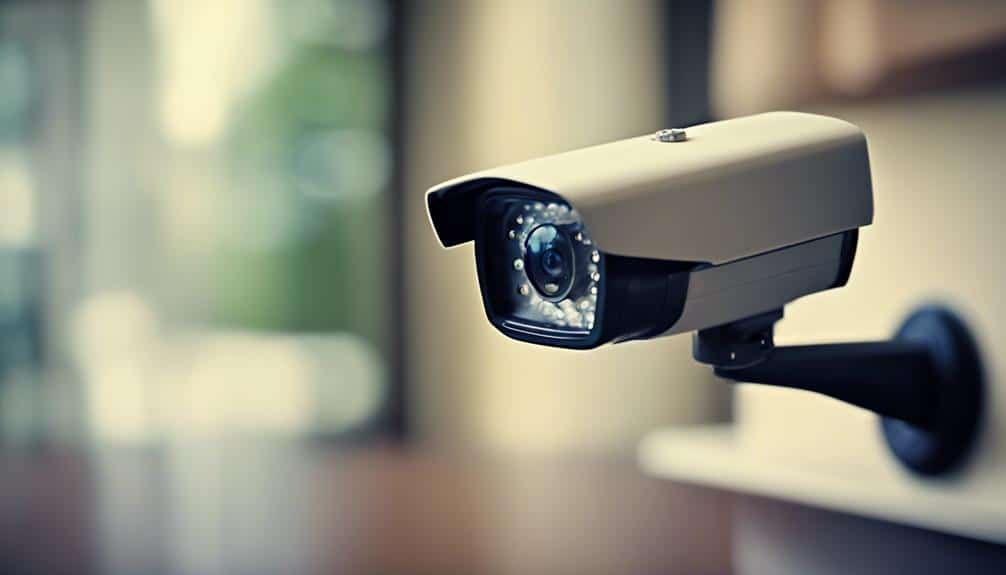 A genuine security camera usually offers remote access through a dedicated app or platform, letting you monitor live feeds and recorded footage from anywhere. This means you can keep an eye on your home or business even while sipping mojitos on a beach vacation.
Dummy cameras, on the other hand, lack any form of network connectivity and don’t emit Wi-Fi signals, making them pretty much useless for actual surveillance.
When evaluating security cameras, check if they require setup for network connectivity. Real cameras need initial configuration to connect to your home network, enabling remote access. If a camera doesn’t ask you to fiddle with any settings or enter a Wi-Fi password, you’re likely dealing with a dummy camera.
Consider using network detection tools or apps to see if the camera appears on your network. Genuine cameras will show up, but dummy cameras will remain ghostly silent.
Moreover, real security cameras often come with additional features like cloud storage and motion alerts. These functionalities are glaringly absent in fake models.
A genuine security camera usually offers remote access through a dedicated app or platform, letting you monitor live feeds and recorded footage from anywhere. This means you can keep an eye on your home or business even while sipping mojitos on a beach vacation.
Dummy cameras, on the other hand, lack any form of network connectivity and don’t emit Wi-Fi signals, making them pretty much useless for actual surveillance.
When evaluating security cameras, check if they require setup for network connectivity. Real cameras need initial configuration to connect to your home network, enabling remote access. If a camera doesn’t ask you to fiddle with any settings or enter a Wi-Fi password, you’re likely dealing with a dummy camera.
Consider using network detection tools or apps to see if the camera appears on your network. Genuine cameras will show up, but dummy cameras will remain ghostly silent.
Moreover, real security cameras often come with additional features like cloud storage and motion alerts. These functionalities are glaringly absent in fake models.
Examine Build Quality

Check for Blinking Lights
A blinking red light often indicates a dummy security camera, as real cameras typically avoid such conspicuous signaling. If you’re trying to spot a fake security camera, look for these blinking red lights. Fake cameras love to flaunt their presence with bright, flashy lights, aiming to scare off potential intruders. However, experienced intruders can easily recognize these gimmicks since real security cameras are designed to be more discreet and avoid attracting attention. Real security cameras generally don’t use blinking red lights. Instead, they might have subtle indicators that are hard to notice unless you’re specifically looking for them. For instance, some real cameras only show a faint glow when they’re recording or detecting motion. This subtlety is a hallmark of genuine security devices, making them effective without being overly obvious. On the other hand, fake cameras often have overly bright or constantly flashing lights. These lights may seem convincing at first glance, but they’re a dead giveaway to anyone who knows what to look for.Inspect Infrared Capability

Check for IR Lights
Real security cameras often have infrared (IR) lights that emit a faint red glow, visible only from close range. This subtle glow is a hallmark of genuine security cameras equipped with night vision capabilities. When you’re trying to distinguish real from fake security cameras, checking for these IR lights is a solid first step. Fake cameras usually lack IR lights entirely, or they might sport some non-functional red lights that don’t actually help with night vision. Imagine you’re trying to secure your home, and you’ve got a mix of real and dummy cameras. At night, only the genuine security camera will have that faint red glow, indicating it’s ready to monitor in low-light conditions. The absence of these IR lights in a camera can be a dead giveaway that it’s just for show.Use Cell Phone Camera
To check if a security camera is genuine, grab your cell phone and use its camera to inspect for infrared (IR) lights. Genuine security cameras typically have dull red IR lights visible through the lens, especially in low-light conditions. Simply point your cell phone camera at the security camera and look for a faint red glow. If you see this glow, congratulations, you’ve got a real deal! If not, you might be looking at a fake security camera. Most modern security cameras include IR lights for effective night vision, making this a reliable test. When you use your cell phone camera, the absence of IR illumination could suggest that the camera is a dummy model. Additionally, keep an eye out for unusual reflections or colors in the lens, which might indicate the presence of fake IR lights rather than functional ones. For those tech-savvy detectives out there, smartphone apps designed to detect hidden cameras can also verify authenticity by checking for IR signals. These apps can add an extra layer of security to your inspection process.Inspect Lens for Dots
Next, inspect the camera’s lens for faint red dots, indicating infrared capability for night vision. Real security cameras often feature these IR lights, which are essential for capturing footage in low-light conditions. When you inspect the lens, look for these tiny red dots. They should emit a subtle glow that’s usually undetectable to the naked eye but can be seen using a cell phone camera. If you don’t see these faint red dots, you might be dealing with one of those fake security cameras. Remember, genuine security setups will have IR lights that activate only in dim environments. On the other hand, fake cameras might skip the IR lights altogether or have conspicuous, always-on red lights that don’t actually do anything. Think of it as the difference between a flashlight and a magic wand—one works, the other just looks cool.Assess Motion Sensors
When you’re checking motion sensors, pay attention to inactive indicator lights, a lack of movement, and an inconsistent detection range. Authentic cameras have reliable motion sensors that activate lights and record movement, whereas fake ones may sit there like a lazy cat, ignoring everything. If the camera seems oblivious to your presence or randomly decides to wake up, it’s probably a dummy.Inactive Indicator Lights
Inactive indicator lights and motion sensors offer key clues in identifying dummy security cameras. When trying to determine if a security camera is real or fake, pay close attention to the indicator lights. Genuine cameras usually have subtle blinking lights that only activate during recording or motion detection, whereas dummy cameras may have inactive indicator lights that flicker erratically or shine too brightly. Here’s a handy checklist to help you spot a fake camera:- Constantly flashing light: Real cameras minimize light interference, so a constant blink could indicate a dummy.
- Erratic flickering: Inactive indicator lights that blink erratically are often a telltale sign of a fake.
- Overly bright lights: Genuine security cameras have subtle, dim lights to avoid drawing attention.
Lack of Movement
While inactive indicator lights are a giveaway, the lack of movement in response to motion is another clear sign of a dummy security camera. Real security cameras are designed with advanced motion detection technology that reacts to movement by recording footage or even tracking the object or person. If you wave your hand in front of a camera and it stays stationary, you’re likely dealing with a dummy camera. Genuine security cameras aren’t shy about showing off their motion detection prowess. They might rotate to follow you, or at the very least, start recording when they detect movement. Dummy cameras, on the other hand, often lack this functionality entirely. Some might even humorously spin around aimlessly, giving the illusion of vigilance without actually doing anything useful. To spot a dummy, closely observe its behavior. If it seems oblivious to your presence, it’s probably a fake. Real cameras will make you feel like you’re in a high-stakes heist movie, with that unmistakable sense of being watched and recorded.Inconsistent Detection Range
A surefire way to spot a dummy security camera is by examining its motion sensors for an inconsistent detection range. Fake security cameras often have motion sensors that are either overly sensitive or completely unresponsive, making them easy to identify if you know what to look for. Real security cameras, on the other hand, are designed with sophisticated technology that guarantees accurate motion detection. Consider these key points when evaluating motion sensors:- False Alarms: Fake cameras may activate without any real movement, causing unnecessary alerts.
- No Response: Some dummy cameras don’t respond at all, even if there’s significant motion in their field of view.
- Sensitivity: Real cameras can distinguish between minor and significant movements, whereas fake ones may trigger over trivial activities.
Evaluate Placement

Verify Brand Authenticity
To verify a security camera’s authenticity, check for identifiable branding like logos, model numbers, and distinct fonts. Authentic security cameras flaunt these details proudly, while dummy models often lack them or use stickers that don’t quite look right. When you’re trying to make your security camera look real, reputable brand names are a must. Consider these steps to tell if a security camera is genuine:- Look for clear logos and model numbers: Real brands imprint their identity all over their products.
- Research the brand online: Genuine companies have official websites, customer reviews, and active online presence.
- Check for misspellings and low-quality stickers: These are red flags that indicate a fake.
Analyze Cable Type

Cable Thickness and Weight
Spotting a dummy security camera involves closely examining the cable thickness and weight, as real cameras usually feature thicker, heavier cables. Genuine camera cables often resemble standard internet cables and have a solid construction, designed to handle both power and data transmission. In contrast, fake security cameras typically use thin cables that are lightweight and flimsy. When you’re trying to determine if a camera is real or fake, consider these points:- Cable Thickness: Real cameras use thicker cables to support more complex internal components.
- Cable Weight: Genuine camera cables feel heavier due to the materials used and their construction.
- Cable Quality: High-quality, well-constructed cables usually indicate a genuine camera, while poorly made, flimsy cables are a red flag.
Hidden Vs. Visible Cables
While cable thickness and weight are key indicators of a camera’s authenticity, examining whether the cables are hidden or visible can provide further clues. In many cases, fake security cameras have visible cables that look flimsy or poorly attached, detracting from their appearance. Real cameras, on the other hand, often employ hidden cables for a sleeker and more professional look. Imagine you’re walking past a security camera and you notice a thin, dangling cable that appears almost weightless. That’s a red flag. Authentic cameras usually have thicker, robust cables hidden away, contributing to both their functionality and aesthetic appeal. Most genuine IP cameras use a single, thicker cable similar to standard internet cables, while fake models might sport a single thin wire, signaling their non-functional nature. Moreover, real cameras are meticulously designed to operate with minimal visible cabling, enhancing their inconspicuousness. Multiple cables protruding from a camera can suggest inauthenticity, as genuine surveillance systems aim for a cleaner installation.Test Recording Features
To test a security camera’s recording features, check for a memory card slot or internal storage, which genuine models typically have. Real security cameras are built to record and store footage, unlike dummy versions that are just for show. Here’s how you can spot the difference:- Indicator Light: Real security cameras often have a subtle indicator light that turns on only when recording. Dummy cameras, on the other hand, might have a bright, constantly flashing light that serves no real purpose.
- Motion Sensor: Authentic cameras will activate their recording features or send alerts when they detect movement. If the camera does nothing when you move in front of it, it’s probably a fake.
- Memory Card Slot: Check the camera for a slot where you can insert a memory card. If it lacks one, it’s likely not a real security camera.
Look for Remote Access

Read User Reviews
User reviews can be a goldmine for identifying the limitations and flaws of dummy security cameras. When you’re trying to determine if a security camera is fake, diving into user reviews can provide you with invaluable insights. Many users share their experiences, pointing out common issues and limitations. Here’s what you might find:- Lack of Realism: Reviews often highlight how some dummy cameras fail to convincingly replicate real ones, lacking essential features like recording capabilities.
- Build Quality: Many users report on the flimsy materials and visible seams of dummy cameras, making them easy to spot as fake.
- Ineffectiveness: Some reviews mention that these cameras don’t deter determined intruders, questioning their effectiveness as a security measure.
Frequently Asked Questions
How Do You Detect if There Is a Hidden Camera?
You can enhance hidden camera detection by using your smartphone for infrared camera visibility, looking for camera lens reflection on surfaces, checking for unusual wire placement, and listening for any subtle noises that indicate activity.How to Tell if Someone Has a Security Camera?
To tell if someone has a security camera, observe camera placement. Look for strategic angles. Consider privacy concerns and familiarize yourself with local surveillance laws. Use detection techniques like checking for infrared lights or visible cables.Do All Security Cameras Have a Red Light?
Not all security cameras have a red light. For red light functionality, many modern security camera types use infrared lights. Dummy camera detection often focuses on camera placement strategies and the presence of flashy, blinking red lights.What Does a Red Dot on a Security Camera Mean?
A red dot on a security camera signifies that it has infrared (IR) lights for night vision. This is essential in distinguishing between camera types, signaling true functionality, and avoiding false security from deterrent factors of dummy cameras.
Facebook
Twitter
LinkedIn
Pinterest


Muchas gracias. ?Como puedo iniciar sesion?